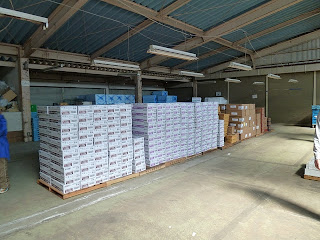Second Harvest Japan (2HJ) started relief activities in the affected areas directly after Tohoku-Kanto earthquake hit. As well as food, fuel was in short supply there, and many people were suffering from cold and hunger. However, roads blocked by the earthquake made delivering supplies difficult.
On the third day after the earthquake, 2HJ staff accompanied CNN reporters to the affected areas and were able to obtain emergency vehicle license numbers. This made it possible for 2HJ to deliver supplies more quickly.
Since just after the earthquake, 2HJ has received many relief supplies from a variety of corporations, including food companies and individuals. Many volunteers rush to sort and load the supplies onto the trucks every day. Two four-ton freight vehicles — one with refrigeration capacity — have made trips to the affected areas every day. As of April 21, 2HJ has delivered more than 40 trucks worth of supplies to the affected areas.
Furthermore, on March 16, 2HJ set up the 2HJ Disaster Restoration Office in Sendai city in collaboration with its partners, Food Bank Tohoku AGAIN and Sendai One Family. After that, 2HJ set up bases in places such as Ishinomaki City and Tome City in Miyagi Prefecture, Iwaki City and Shinchi-machi in Fukushima Prefecture, and Ofunato City in Iwate Prefecture to collect information and distribute supplies. 2HJ is working hard to provide continuous and intensive support to the people who are most in need.
2HJ will continue accepting relief supplies from corporations and individuals and deliver them to the affected areas. While carrying on its usual activities such as food banking and running a soup kitchen, 2HJ is planning to provide emergency assistance to the victims in the short term, and food aid to accompany life and reconstruction assistance in the long term.
On the third day after the earthquake, COO of 2HJ got into a town that had been swept away by the tsunami. He had no words to describe the catastrophic condition of the town. He says that he felt strongly that "Only continuous and long-term support can reconstruct this situation." We sincerely look forward to your continued support and cooperation. It's going to be a long way, but we must go on!
(This is a first-hand account from Otake-san, 2HJ COO)
I arrived on the ground on the morning of the third day after the earthquake. After delivering gas canisters and heavy fuel oil to Food Bank Tohoku AGAIN, I joined the CNN crew and got into Rikuzentakada City in Iwate Prefecture. The shocking scene I saw was really beyond words.
The Self-Defense Force was continuing relief activities through the aftershocks and tsunami warnings, but I saw few inhabitants. Where had they gone? Had they already escaped from the town? Everything had been swept away. It was so catastrophic—as if it had been bombed—that you couldn't believe that there had been a town, houses and people living there just a few days before.
I felt myself to be really helpless before the devastation. No matter how many packages we could deliver by truck, they would never be enough... but then I thought about it some more; even if it might be just a drop in the ocean, we must do what we can do now.
The activities that 2HJ has provided are also the same. We cannot save all the poor people or people in need but still we have continued the activities in a step-by-step way. I felt that was the most essential thing.
There are no supplies not only in the shelters, but also in the affected areas, and there are kilometer-long lines in front of supermarkets and gas stations. Only young and vigorous people, however, can stand in lines in below freezing temperatures. Vulnerable groups, including the elderly, people in poor health, and the physically challenged, are completely left behind. But those people also need support.
A mother and her young daughter were standing in a soup kitchen line. Apparently it was the first time for them to be in a soup kitchen line. I was shocked by their reserved and apologetic attitude. It was so different from what we had seen in the soup kitchens in Tokyo.
This will be really a long road, but 2HJ will go on applying the know-how it has accumulated over the years to help.
























